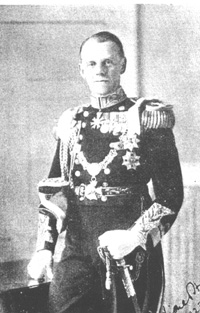|
President PWSTH Limehouse
Admiral Sir Lionel Halsey G.C.M.G, G.C.V.O, K.C.I.E
/back
 Sir Lionel Halsey
(1872-1949) served at the naval battles of Heligoland Bight, Dogger Bank
and Jutland prior to his appointment as Fourth Sea Lord in December 1916. Sir Lionel Halsey
(1872-1949) served at the naval battles of Heligoland Bight, Dogger Bank
and Jutland prior to his appointment as Fourth Sea Lord in December 1916.
Having joined the Royal Navy as a cadet in 1885 he was promoted to
Lieutenant eight years later. He served in the South African War of
1899-1902, during the course of which he played a role in the defence of
Ladysmith. He was promoted Commander in 1901 and Captain four years later.
In the pre-war years before 1914 Halsey served as Flag Captain to the
Commander-in-Chief, Australia, Sir Wilmot Fawkes. 1912 brought Halsey
command of HMS New Zealand.
Halsey saw more wartime service than many of his contemporaries. In August
1914 he again commanded HMS New Zealand, and once more at Dogger Bank five
months later.
Called upon by Sir John Jellicoe, the commander of the Grand Fleet, to be
his Captain of the Fleet in June 1915, he was on board HMS Iron Duke
during the Battle of Jutland on 31 May/1 June 1916.
Subsequently promoted to Rear-Admiral he became Fourth Sea Lord in
December 1916 when he followed Jellicoe to the Admiralty (where the latter
was appointed First Sea Lord). Eric Geddes' appointment as First of the
Admiralty in July (replacing Sir Edward Carson) brought Halsey a brief to
oversee naval design.
In October 1918 - the month before the war ended - Halsey was appointed
Commander-in-Chief of the Australian Navy.
Sir Lionel Halsey, who was knighted in 1918, died in 1949.
The above photograph was presented to the PWSTH in 1923 by
Admiral Sir Lionel Halsey GCMG, GCVO, KCIE
The above information and photograph is courtesy
of Michael Duffy at Firstworldwar.com
http://www.firstworldwar.com/bio/halsey.htm |